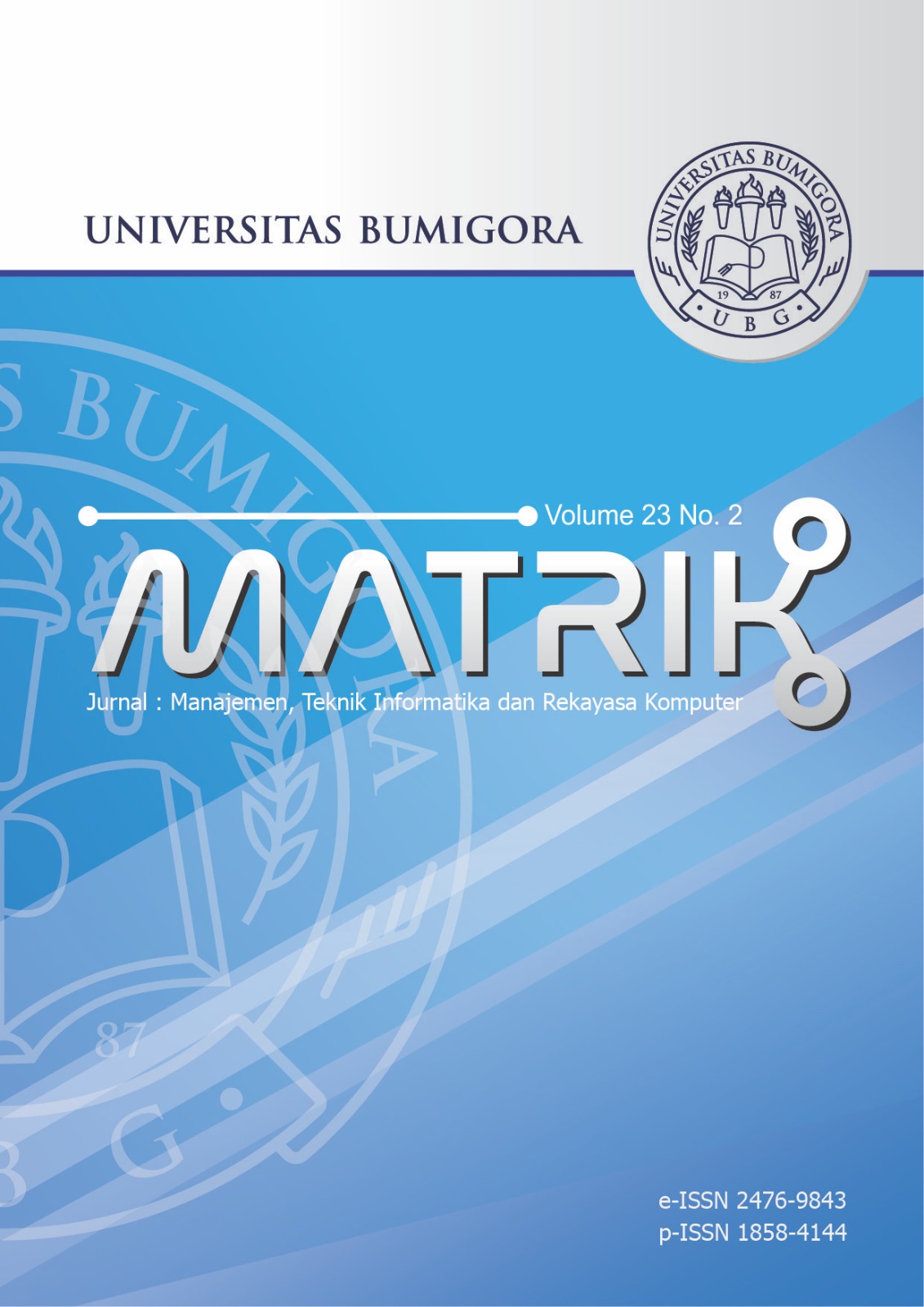Learning Accuracy with Particle Swarm Optimization for Music Genre Classification Using Recurrent Neural Networks
DOI:
https://doi.org/10.30812/matrik.v23i2.3037Keywords:
Learning Rate, Particle Swarm Optimization, Recurrent Neural Network (RNN)Abstract
Deep learning has revolutionized many fields, but its success often depends on optimal selection hyperparameters, this research aims to compare two sets of learning rates, namely the learning set rates from previous research and rates optimized for Particle Swarm Optimization. Particle Swarm Optimization is learned by mimicking the collective foraging behavior of a swarm of particles, and repeatedly adjusting to improve performance. The results show that the level of Particle Swarm Optimization is better previous level, achieving the highest accuracy of 0.955 compared to the previous best accuracy level of 0.933. In particular, specific levels generated by Particle Swarm Optimization, for example, 0.00163064, achieving competitive accuracy of 0.942-0.945 with shorter computing time compared to the previous rate. These findings underscore the importance of choosing the right learning rate for optimizing the accuracy of Recurrent Neural Networks and demonstrating the potential of Particle Swarm Optimization to exceed existing research benchmarks. Future work will explore comparative analysis different optimization algorithms to obtain the learning rate and assess their computational efficiency. These further investigations promise to improve the performance optimization of Recurrent Neural Networks goes beyond the limitations of previous research.
Downloads
References
mining technology in big data era,†Journal of Evidence-Based Medicine, vol. 13, no. 1, pp. 57–69, 2020, https://doi.org/10.
1111/jebm.12373.
[2] A. Lewkowycz, Y. Bahri, E. Dyer, J. Sohl-Dickstein, and G. Gur-Ari, “The large learning rate phase of deep learning: the
catapult mechanism,†arXiv:2003.02218v1, no. 4 Mar, 2020.
[3] Y. Ming, X. Meng, C. Fan, and H. Yu, “Deep learning for monocular depth estimation: A review,†Neurocomputing, vol. 438,
pp. 14–33, 2021, https://doi.org/10.1016/j.neucom.2020.12.089.
[4] S. Xie, Z. Yu, and Z. Lv, “Multi-disease prediction based on deep learning: A survey,†CMES - Computer Modeling in Engineering
and Sciences, vol. 127, no. 3, 2021, https://doi.org/10.32604/CMES.2021.016728.
[5] S. Minaee, N. Kalchbrenner, E. Cambria, N. Nikzad, M. Chenaghlu, and J. Gao, “Deep Learning-based Text Classification: A
Comprehensive Review,†ACM Computing Surveys, vol. 54, no. 3, pp. 1–40, apr 2022, https://doi.org/10.1145/3439726.
[6] M. R. Karim, O. Beyan, A. Zappa, I. G. Costa, D. Rebholz-Schuhmann, M. Cochez, and S. Decker, “Deep learning-based
clustering approaches for bioinformatics,†Briefings in Bioinformatics, vol. 22, no. 1, pp. 393–415, 2021, https://doi.org/10.
1093/bib/bbz170.
[7] J. Konar, P. Khandelwal, and R. Tripathi, “Comparison of Various Learning Rate Scheduling Techniques on Convolutional
Neural Network,†2020 IEEE International Students’ Conference on Electrical, Electronics and Computer Science, SCEECS
2020, 2020, https://doi.org/10.1109/SCEECS48394.2020.94.
[8] M. Nagy, M. El-Sersy, M. A. Mohamed, and K. S. Alou, “A Modied Method for Detecting DDoS Attacks Based on Articial
Neural Networks,†The 1st International Conference on Information Technology (IEEE/ITMUSTCONF), 2019.
[9] A. R. Asif, A. Waris, S. O. Gilani, M. Jamil, H. Ashraf, M. Shafique, and I. K. Niazi, “Performance evaluation of convolutional
neural network for hand gesture recognition using EMG,†Sensors (Switzerland), vol. 20, no. 6, pp. 1–11, 2020, https://doi.org/
10.3390/s20061642.
[10] J. Jepkoech, D. M. Mugo, B. K. Kenduiywo, and E. C. Too, “The Effect of Adaptive Learning Rate on the Accuracy of
Neural Networks,†International Journal of Advanced Computer Science and Applications, vol. 12, no. 8, pp. 736–751, 2021,
https://doi.org/10.14569/IJACSA.2021.0120885.
[11] R. Guha, “Benchmarking Gradient Based Optimizers’ Sensitivity to Learning Rate,†SSRN Electronic Journal, no. January, pp.
1–33, 2023.
[12] Y. Aprizal, R. I. Zainal, and A. Afriyudi, “Perbandingan Metode Backpropagation dan Learning Vector Quantization (LVQ)
Dalam Menggali Potensi Mahasiswa Baru di STMIK PalComTech,†MATRIK : Jurnal Manajemen, Teknik Informatika dan
Rekayasa Komputer, vol. 18, no. 2, pp. 294–301, 2019, https://doi.org/10.30812/matrik.v18i2.387.
[13] M. A. Jamal, M. Brown, M. H. Yang, L. Wang, and B. Gong, “Rethinking Class-Balanced Methods for Long-Tailed Visual
Recognition from a Domain Adaptation Perspective,†Proceedings of the IEEE Computer Society Conference on Computer
Vision and Pattern Recognition, pp. 7607–7616, 2020, https://doi.org/10.1109/CVPR42600.2020.00763.
[14] M. Kim and H. Byun, “Learning Texture Invariant Representation for Domain Adaptation of Semantic Segmentation,†Proceedings
of the IEEE Computer Society Conference on Computer Vision and Pattern Recognition, pp. 12 972–12 981, 2020,
https://doi.org/10.1109/CVPR42600.2020.01299.
[15] F. Mulier and V. Cherkassky, “Learning rate schedules for self-organizing maps,†Proceedings - International Conference on
Pattern Recognition, vol. 2, pp. 224–228, 1994, https://doi.org/10.1109/icpr.1994.576908.
[16] B. Bischl, M. Binder, M. Lang, T. Pielok, J. Richter, S. Coors, J. Thomas, T. Ullmann, M. Becker, A. L. Boulesteix, D. Deng,
and M. Lindauer, “Hyperparameter optimization: Foundations, algorithms, best practices, and open challenges,†Wiley Interdisciplinary
Reviews: Data Mining and Knowledge Discovery, vol. 13, no. 2, pp. 1–43, 2023, https://doi.org/10.1002/widm.1484.
[17] ANDRADA, “GTZAN Dataset - Music Genre Classification,†2020.
[18] A. Anggrawan, “Application of KNN Machine Learning and Fuzzy C-Means to Diagnose Diabetes,†vol. 22, no. 2, pp. 405–418,
2023, https://doi.org/10.30812/matrik.v22i2.2777.
[19] Z. Allen-Zhu and Y. Li, “Can SGD learn recurrent neural networks with provable generalization?†Advances in Neural Information
Processing Systems, vol. 32, no. NeurIPS, 2019.
[20] M. Jahandideh-Tehrani, O. Bozorg-Haddad, and H. A. Lo´aiciga, “Application of particle swarm optimization to water management:
an introduction and overview,†Environmental Monitoring and Assessment, vol. 192, no. 5, 2020, https://doi.org/10.1007/
s10661-020-8228-z.
[21] T. H. Zhao, M. I. Khan, and Y. M. Chu, “Artificial neural networking (ANN) analysis for heat and entropy generation in flow of
non-Newtonian fluid between two rotating disks,†Mathematical Methods in the Applied Sciences, vol. 46, no. 3, pp. 3012–3030,
2023, https://doi.org/10.1002/mma.7310.
Matrik:
Downloads
Published
Issue
Section
How to Cite
Similar Articles
- Muhammad Ibnu Choldun Rachmatullah, The Application of Repeated SMOTE for Multi Class Classification on Imbalanced Data , MATRIK : Jurnal Manajemen, Teknik Informatika dan Rekayasa Komputer: Vol. 22 No. 1 (2022)
- Annisa Nurul Puteri, Arizal Arizal, Andini Dani Achmad, Feature Selection Correlation-Based pada Prediksi Nasabah Bank Telemarketing untuk Deposito , MATRIK : Jurnal Manajemen, Teknik Informatika dan Rekayasa Komputer: Vol. 20 No. 2 (2021)
- Sri Suwarno, Erick Kurniawan, Multi-Level Pooling Model for Fingerprint-Based Gender Classification , MATRIK : Jurnal Manajemen, Teknik Informatika dan Rekayasa Komputer: Vol. 22 No. 2 (2023)
- Evan Tanuwijaya, Angelica Roseanne, Modifikasi Arsitektur VGG16 untuk Klasifikasi Citra Digital Rempah-Rempah Indonesia , MATRIK : Jurnal Manajemen, Teknik Informatika dan Rekayasa Komputer: Vol. 21 No. 1 (2021)
- Anthony Anggrawan, Analisis Deskriptif Hasil Belajar Pembelajaran Tatap Muka dan Pembelajaran Online Menurut Gaya Belajar Mahasiswa , MATRIK : Jurnal Manajemen, Teknik Informatika dan Rekayasa Komputer: Vol. 18 No. 2 (2019)
- Anugerah Bagus Wijaya, Suliswaningsih Suliswaningsih, Argiyan Dwi Pritama, Meningkatkan Rasa Nasionalisme Siswa Melalui Game Base Learning , MATRIK : Jurnal Manajemen, Teknik Informatika dan Rekayasa Komputer: Vol. 19 No. 1 (2019)
- Angelina Ervina Jeanette Egeten, PENGARUH PEMBELAJARAN E-LEARNING DAN KEBIASAAN BELAJAR TERHADAP PENINGKATAN KOMPETENSI MAHASISWA PASCASARJANA PADA UNIVERSITAS BINA NUSANTARA , MATRIK : Jurnal Manajemen, Teknik Informatika dan Rekayasa Komputer: Vol. 16 No. 2 (2017)
- Jihadil Qudsi S., Anthony Anggrawan, EVALUASI PRODUK PEMBELAJARAN MULTIMEDIA (PELIN) EVALUATION OF LEARNING MULTIMEDIA PRODUCT (PELIN) , MATRIK : Jurnal Manajemen, Teknik Informatika dan Rekayasa Komputer: Vol. 16 No. 1 (2016)
- Tri Oktarina, Media Pembelajaran Online untuk Mendukung Belajar Pada Stebis Islam Darussalam , MATRIK : Jurnal Manajemen, Teknik Informatika dan Rekayasa Komputer: Vol. 19 No. 2 (2020)
- Gustin Setyaningsih, Muhamad Awiet Wiedanto Prasetyo, Debby Ummul Hidayah, Penerapan Aplikasi Media Pembelajaran pada SMP N 1 Nusawungu Berbasis Smartphone Android , MATRIK : Jurnal Manajemen, Teknik Informatika dan Rekayasa Komputer: Vol. 18 No. 2 (2019)
You may also start an advanced similarity search for this article.
Most read articles by the same author(s)
- Aditya Dwi Putro, Arief Hermawan, Pengaruh Cahaya dan Kualitas Citra dalam Klasifikasi Kematangan Pisang Cavendish Berdasarkan Ciri Warna Menggunakan Artificial Neural Network , MATRIK : Jurnal Manajemen, Teknik Informatika dan Rekayasa Komputer: Vol. 21 No. 1 (2021)
- Arief Hermawan, Adityo Permana Wibowo, Akmal Setiawan Wijaya, The Improvement of Artificial Neural Network Accuracy Using Principle Component Analysis Approach , MATRIK : Jurnal Manajemen, Teknik Informatika dan Rekayasa Komputer: Vol. 22 No. 1 (2022)


.png)












